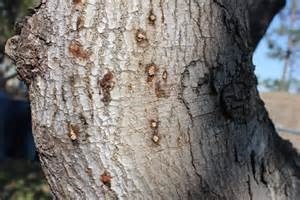As discussed in previous issues of this newsletter, polyphagous shot hole borer (PSHB; Euwallacea sp.) is a new pest/fungal complex attacking a wide variety of host trees in Southern California, from avocado to common residential and street trees and native oaks and riparian species. The PSHB is morphologically identical to the tea shot hole borer, E. fornicatus, but a genetic analysis confirmed that this is a new species of ambrosia beetle. PSHB has been found to carry several symbiotic fungi, including new fungal species Fusarium euwallacea, andan undescribed Graphium species.It was first identified in 2003 in Whittier Narrows, an undeveloped riparian area in Los Angeles County, and was officially first linked to tree injury and mortality in a residential avocado in 2012. Since then, the pest complex, also referred to as Fusarium die-back, has spread throughout Southern California and is now present in Los Angeles, Orange, San Bernardino, Western Riverside, and San Diego counties. The population in San Diego County is a different genotype from that found in the rest of the region, possibly indicating a separate introduction. The pest/disease complex has caused significant impacts to the avocado industry in Israel, and is now spreading in commercial groves from Escondido to Fallbrook. It has caused injury and mortality of hundreds of ornamental trees in the urban areas, impacting roadways, botanical gardens, parks, and private residences, and impacts all major native riparian trees species. The official list of reproductive hosts, meaning trees that can support growth and reproduction of the beetles and fungi, includes 35 species with several having been confirmed in just the past few months.
The plant pathology, IPM, environmental horticulture, and natural resource management teams working on this pest at UCR and UC Cooperative Extension in San Diego, Orange, Los Angeles, and Ventura Counties have put together several useful tools that can help you manage this pest. These include a new field identification card set, a decision tree for tree removal, a guide to managing infested plant materials, and information about how to report an infested tree and how to collect samples for lab identification, as well as a continuously updated web-based map. You can find these at www.pshb.org.
To determine if your trees are affected by this pest:
- Look for a small (tip of a ball point pen) round entry/exit hole surrounded by wet discoloration of the outer bark
- Follow the gallery to look for the beetle (may or may not be present)
- Look for other hosts (Castor bean, sycamore, maple, coast live oak, goldenrain, liquidambar) showing symptoms of the beetle/disease
- Report suspect tree infestations to eskalenlab@gmail.com with the following information:
o Your contact info (name, city, phone number, email)
o Suspect tree species
o Description of suspect tree's location (and/or GPS coordinates)
o Description of suspect tree's symptoms
o Photos of suspect tree and close-up photos of symptoms
- If symptom photos and descriptions indicate it might be PSHB/FDB a field assessment may be needed or a sample can be submitted following detailed directions on how to collect and submit a sample for fungal confirmation at pshb.org.
To protect your trees, avoid movement of infested firewood and chipped material out of infested areas. Infested material should be chipped to under 1”, wrapped in clear plastic, and solarized on site for up to 6 mos (depending upon environmental conditions). Research is ongoing in the use of insecticides and fungicides, as well as exploration of the use of endophytic bacteria as a biocontrol agent. If you suspect that you have found this beetle or seen symptoms of the Fusarium dieback on your tree please contact the Ventura CE office, your pest control advisor or qualified arborist, or contact UC Extension Plant Pathologist Dr. Akif Eskalen by at akif.eskalen@ucr.edu. For more information visit www.pshb.org or http://eskalenlab.ucr.edu/avocado.html.
PSHB DAmage
Attached Images:
